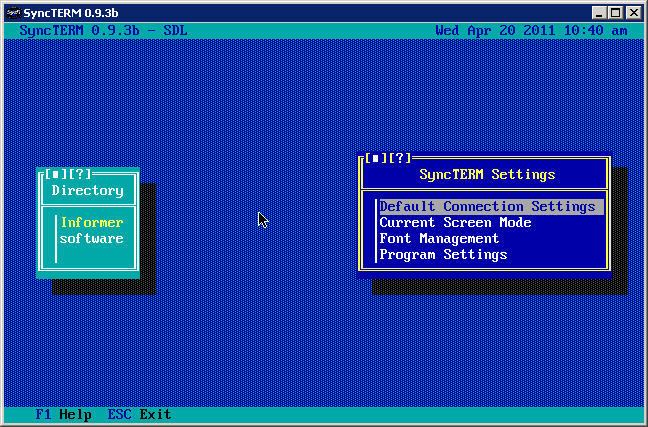

- #Syncterm on wondows crashes c64 mode install
- #Syncterm on wondows crashes c64 mode Pc
- #Syncterm on wondows crashes c64 mode license

#Syncterm on wondows crashes c64 mode install
SELECT’s obscurity primarily lies in its non-obvious name or usage, nor the fact that it’s actually needed to install DOS it’s sufficient to simply copy the files to the hard disk. Running FORMAT C: /S created a bootable drive, but something oft-forgotten was that IBM actually provided an installation utility known as SELECT. Even at the time, this was somewhat constrained and Compaq DOS was the first (to the best of my knowledge) to remove this limitation. Each individual partition is limited, however, to 32 MiB. Likewise, FDISK and FORMAT were available to partition the hard drive for installation.
#Syncterm on wondows crashes c64 mode Pc
PC DOS 3.3 loaded just fine in VirtualBox and - with the single 720 KiB floppy being bootable - immediately dropped me to a command prompt. However, due to its age, it has some quirks that would disappear with the later and more common DOS versions. Given that PC-DOS was built for IBM’s own line of PCs, it’s generally considered the most “generic” version of the pre-DOS 5.0 versions, and this version was chosen for our base.
#Syncterm on wondows crashes c64 mode license
Instead, system builders would license the DOS OEM Adaptation Kit and create their own DOS such as Compaq DOS 3.3. The reason is that DOS didn’t exist as a standalone product at the time.

You might notice I didn’t say Microsoft DOS 3.3. To reduce the number of potential headaches, I decided to simply install PC-DOS 3.3, and give Windows what it wants. However, even if this version check is bypassed, there are supposedly known issues with running COMMAND.COM. Part of this is due to an internal version check which can be worked around with SETVER. One quirk however with this specific version of Windows is that it blows up when run on anything later than DOS 3.3. Windows 1.0, like all pre-95 versions, required DOS to be pre-installed. To that end, I recorded a video on YouTube that provides a look into the world of programming for Windows 1.0, and then testing the backward compatibility of Windows through to Windows 10.įor those less inclined to watch a video, my write-up of the experience is past the fold and an annotated version of the file is available on GitHub ( )īefore we even get into the topic of HELLO.C though, there’s a fair bit to be said about these ancient versions of Windows. Recently, I was inspired to investigate the original HELLO.C for Windows 1.0, a 125 line behemoth that was talked about in hush tones. For those who do programming work of any sort, you’ll also be familiar with “Hello World”, the first program most, if not all, programmers write in their careers.Ī sample hello world program might look like the following: #include About three years ago, I ran a series of articles about restoring Xenix 2.2.3c, and I’m far overdue on writing a new one. The following is a guest post by NCommander of SoylentNews fame!įor those who’ve been long-time readers of SoylentNews, it’s not exactly a secret that I have a personal interest in retro computing and documenting the history and evolution of the Personal Computer.


 0 kommentar(er)
0 kommentar(er)
